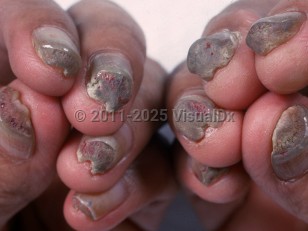Historically, PC was classified based on typical dimerization of the keratins (eg, KRT6a/16, KRT6b/17); however, this has been subsumed by classification according to genotype. All subtypes feature some degree of palmar keratoderma.
Phenotypic associations with each genotype include:
- KRT6A mutations occur most commonly and have the greatest incidence of oral leukokeratosis, nursing difficulty, ear pain, cerumen accumulation, and hoarseness. Palmar keratoderma, cysts, and natal teeth may also be present. Angular cheilitis, corneal dyskeratosis, and cataracts have also been described. This was formerly type 3 PC. Patients with this mutation are also likely to be identified at a young age.
- KRT16 mutations confer the greatest incidence of palmar keratoderma, painful plantar keratoderma requiring walking aids, and oral leukokeratosis. Other features occur less often, and natal teeth are unlikely. This was formerly known as Jadassohn-Lewandowski syndrome.
- KRT17 mutations are most often associated with natal teeth and cysts, and least frequently with plantar keratoderma, although this still occurs in up to 80% of these patients. Bullae and hyperhidrosis of the palms and soles may also be reported. This was formerly known as Jackson-Lawler syndrome.
- KRT6B mutations are most often associated with cystic eruptions (approximately 70%), compared to oral leukokeratosis, hoarseness, and cerumen accumulation, which occur in less than 25% of one cohort. Natal teeth are not likely to erupt when this mutation is present. Laryngeal lesions, intellectual disability, and alopecia have also been reported in what was formerly known as type 4 PC, but these findings are not necessarily specific for this mutation.
- KRT6C mutations are the least frequently identified. Virtually all patients with this mutation have plantar keratoderma. Palmar involvement, on the other hand, is infrequent. Natal teeth, feeding difficulty, and ear pain also often occur. Cysts and oral leukokeratosis occur less often than with other keratin mutations.



